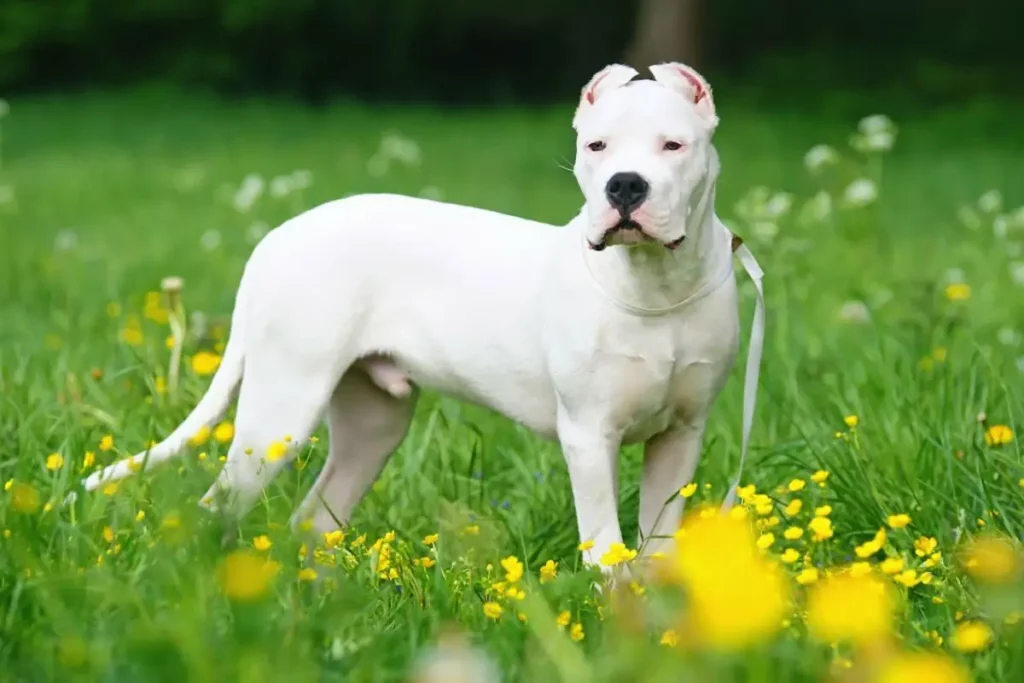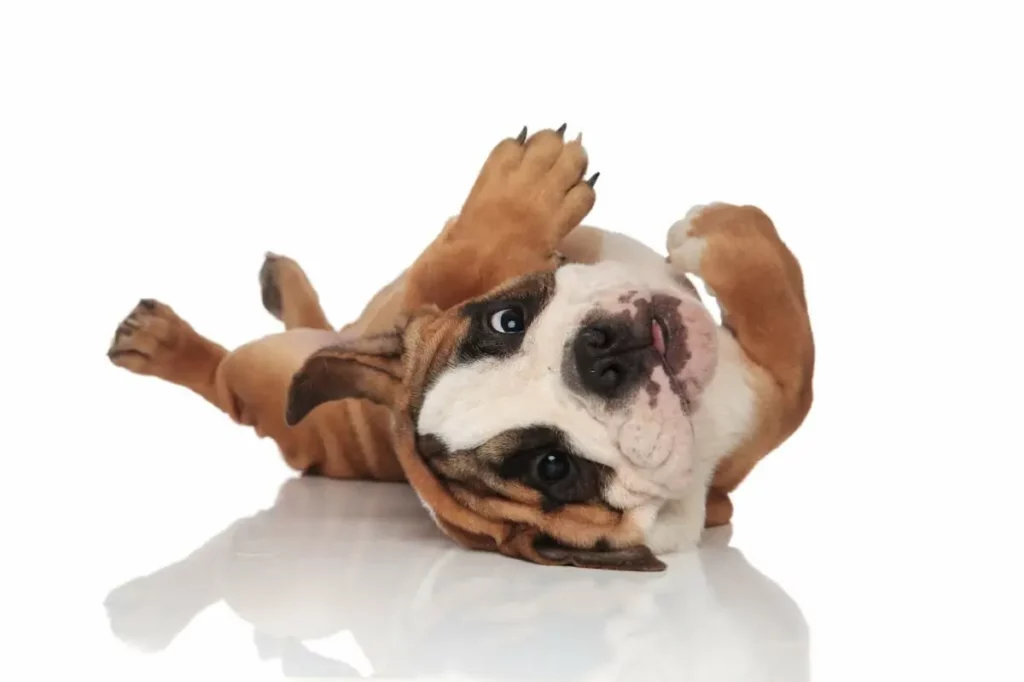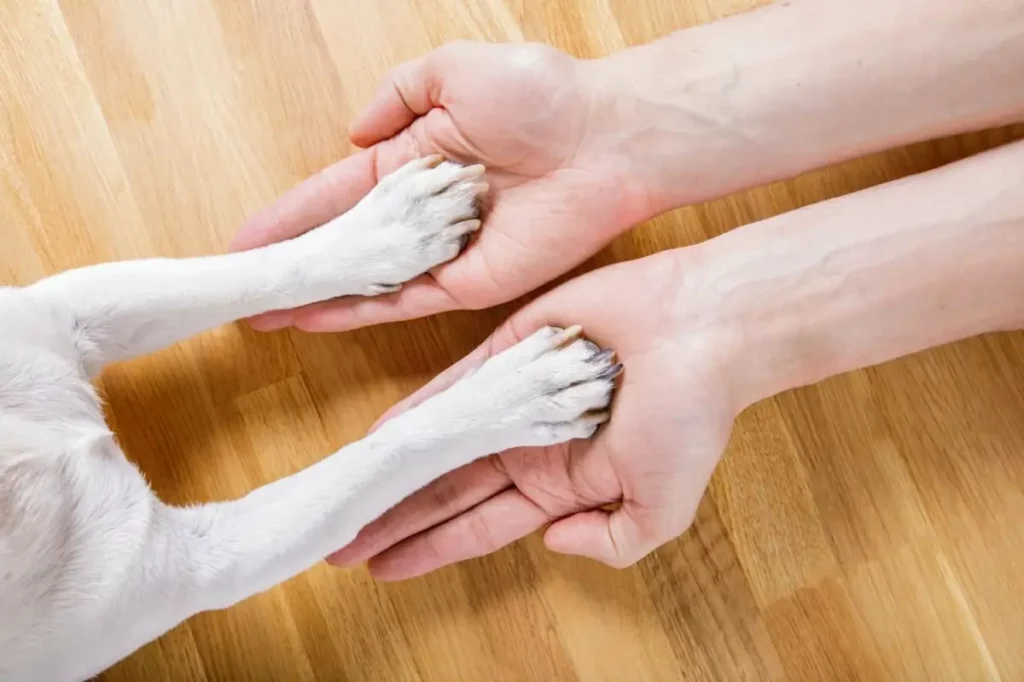The powerful Dogo Argentino is sometimes referred to as the Argentinian Mastiff. This impressive dog is fearless yet sensitive and has an almost feline grace. While an energetic outdoors dog, the Dogo Argentino is a calm and happy indoor dog.
Essentially a white Mastiff, the muscular Dogo Argentino was bred for its robust strength and big-game hunting abilities. Interestingly, while this large dog is an aggressive hunter, he actually has a pretty happy disposition, especially with his human family. Fiercely loyal, the Dogo Argentino requires strict boundaries and an experienced owner capable of handling this large breed.
Your dog’s yard must have a strong and tall fence because the Dogo Argentino’s natural instinct is to wander off and chase small animals. It’s also essential that your pet be socialized with other pets and humans to curb their natural caution around other animals and strangers.
Don’t leave your dog alone for long periods because this breed can quickly become bored and indulge in destructive behavior. These dogs need to stay active. When placed in a loving home and with rigid training, your Dogo Argentino will make a fantastic, courageous watchdog and a loving and loyal family member.
History of the Argentinian Mastiff Dog Breed & Antonio Nores Martinez

This large breed has a dogfighting ancestry, so that aggression can be an issue. Socializing is key to developing the discriminating, stable temperament this dog is now known for at a very young age. As a descendant of the Fighting Dog of Córdoba (now extinct), this large, fierce breed of dogs were kept for fighting.
In the 1920s, an Argentinian breeder named Antonio Nores Martinez wanted to breed a hunting dog capable of being a loyal companion while also handling his homeland’s terrain. He aimed to replace the dog’s natural fighting instinct with the need to hunt and reduce the dog’s desire to fight to work within a pack through breeding. After several breeding experiments, Martinez achieved what he set out to do. The result was the Dogo Argentino breed.
While this muscular dog now has a strong prey drive, perfect for hunting in Argentina’s rugged terrain, it’s also become a trusted companion and a loyal family guardian. Unfortunately, due to its powerful strength and fearlessness, the Dogo Argentino is often used in dogfighting rings.
Read also: Mastiff Breeds – 20 Types of Mastiffs
Important Breed Notes for Dogo Argentinos
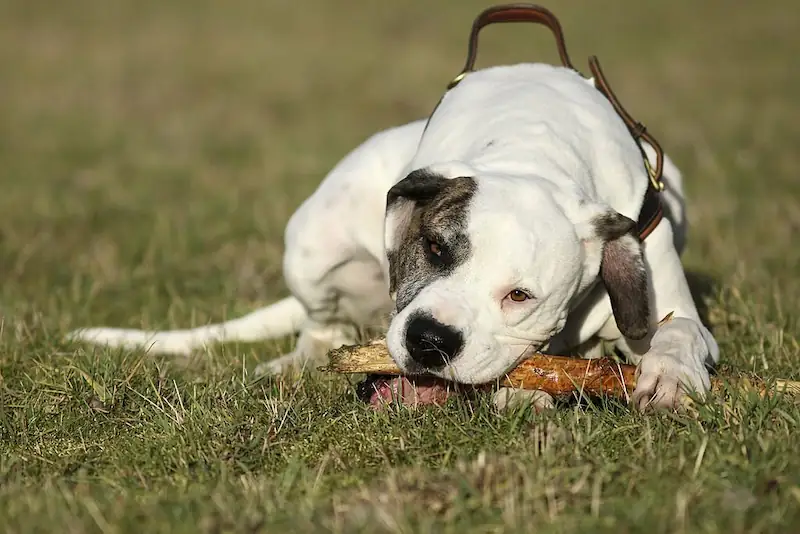
- While the Dogo Argentino was bred from fighting dogs, Martinez successfully eradicated its aggressive traits to enable these powerful dogs to work together with other dogs during hunts. Today, this breed has no natural tendency to fight, but unfortunately, their strength and courage inspire some people to train them to fight.
- This use of the Dogo Argentino in dogfighting rings has resulted in this breed being deemed a dangerous breed, with several countries like the Cayman Islands, Australia, Fiji, Denmark, Ukraine, Singapore, and Iceland, banning the breed altogether.
- It’s illegal to own a Dogo Argentino in some countries, like the UK, without lawful authority.
- Dogo Argentinos make ideal working dogs for the Military, Police, and Search and Rescue efforts.
- They’re excellent watchdogs, but they’re most beloved for their courage and loyalty.
- Dogs with white coats can often be affected by pigment-related deafness in one or both ears and around 10% of Dogo Argentinos suffer from this affliction.
- To ensure your Dogo Argentino is well-behaved, it’s vitally important that early training and socialization begin when your dog is just a small puppy.
- Because these dogs can be strong-willed and are physically very strong, you’ll need an experienced trainer who doesn’t resort to force or physical punishment.
- The Dogo Argentino is not a breed for novice or inexperienced owners.
- Often confused with the American Bulldog, the Dogo has a white coat and is taller. They’re also sometimes confused with the American Pit Bull Terrier, but the Dogo is quite different and much bigger.
Size and Weight
Male Dogo Argentinos are typically taller than females by about an inch and grow to a height of approximately 24 to 27 inches at the shoulder. These dogs usually weigh anywhere between 80 and 100 lbs.
Because Dogo Argentinos have large, broadheads, they’re often confused with the American Pit Bull Terrier and the American Bulldog. With a typically longer body than it is tall, these sizes are referred to as “breed standard’; however, Dogo Argentina’s can be either bigger or smaller.
Personality And Temperament
The Dogo Argentino is an excellent watchdog. They’re a highly territorial, loyal breed and will fiercely defend their human family. The downside is that their strong prey drive does not make them good companion pets for other animals like smaller dogs or cats, but it does make them great hunters – their sheer strength and ferocity make them capable of taking down wild boars.
The Dogo Argentino is an independent dog, so they require an experienced owner or trainer to take on their training needs, especially socialization. These dogs are not exactly renowned for welcoming strangers or other dogs! Training should begin while they are just a small puppy.
This breed requires plenty of mental stimulation and exercise. Unless you live a physical lifestyle and are prepared to stimulate your dog mentally and physically, this dog is not for you. Don’t even consider this breed if you live in an apartment.
Potential Health Issues
There are a few health problems that the Dogo Argentino can be predisposed to, with the main one being deafness. It’s believed that approximately 10% of Dogos are deaf in one or both ears. This affliction is known as Pigment-Related Deafness because of the dog’s white coat. This affliction is also found in other breeds with white coats, including Boxers, Dalmatians, and Bull Terriers.
Other health issues that may affect the Dogo Argentino include glaucoma, hypothyroidism, and laryngeal paralysis. Hip dysplasia, which is quite common among large breeds, can also be an issue.
Physical and Mental Care
Your Dogo Argentino must receive plenty of mental stimulation and lots of exercise because this breed quickly becomes anxious, bored, and destructive when their needs are not being met.
Like any other dog breed, this breed requires regular grooming, vet checkups, and teeth to be kept clean. Their nails should be trimmed monthly, and their ears should be checked weekly. Please consult your veterinarian about caring for your Dogo Argentino at home and follow their instructions.
Read also: Mountain Cur – Breed Info for the American Pioneer Dog
Feeding Your Dogo Argentino
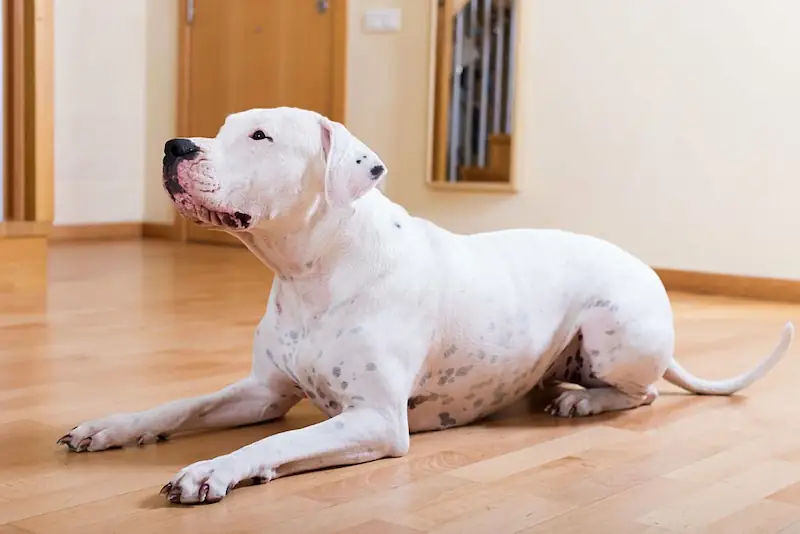
Besides lots of fresh, clean water, your Dogo Argentino will need a diet specifically formulated for large-breed dogs. Because this is a breed with high energy levels, this will need to be taken into account. Their feeding requirements will change from puppyhood as they grow into adulthood. Again, speak to your veterinarian about an appropriate feeding plan for your dog. You may also choose to seek guidance from a professional nutritionist if you have any concerns about nutrition.
Grooming and Coat Color for the Dogo Argentino
Your Dogo Argentino will have a short, all-white coat, and he may have a black spot on his head. The short coat should mean easy maintenance; however, your dog’s sheer size could make the grooming process quite long. Your dog will require weekly brushing and, unless he gets filthy, he should have a bath every three months. These dogs do shed quite a bit but, because they have a short coat length, their shedding is not as noticeable as it would be with a long-haired dog. A good lint roller should take care of this problem.
Children And Other Pets
Providing your Dogo Argentino has been properly introduced to your family and become accustomed to their presence, you’ll find that this huge dog will become a very loyal and loving family member.
However, you should be aware that your Dogo will not naturally like strangers, so beware of children visiting your home. No children, even your own children, should be left unsupervised with dogs, and it’s vitally important that your dog is trained right from a small puppy on how to interact with other animals. You must begin socializing your Dogo Argentino early and teach him to accept and interact with humans and animals. You can’t start training your Dogo too early.
Read also: Are Goldendoodles Good Dogs? (Temperament, Personality, Health)
Dogo Argentino Puppy
Does the Dogo Argentino bark a lot?
This dog can bark, of course, but it doesn’t seem to be as relentless about it as other breeds. You should only expect your friend to bark when he is trying to warn you of a possible danger to your home or family.
One of the interesting facts about the Dogo Argentino is that it can be a little scary when you hear your Dogo Argentino barking for the first time. This breed is known for having a very strong and deep bark, perfect for scaring off intruders and threats to the family. Dogo Argentino facts
Are Dogo Argentinos good swimmers?
In fact, most Dogo Argentinos really enjoy swimming! This breed is known for having extremely strong muscles and good balance, making it easy for them to keep their head above water and glide smoothly through the water.
But swimming isn’t her only favorite activity. This breed also makes a great companion for long walks, jogs, and hikes! The activity level of the average Dogo Argentino is quite high, making this breed an ideal companion for anyone who enjoys spending time outdoors.
How fast can a Dogo Argentino run?
There aren’t many organizations that actually measure how fast certain dog breeds can run. However, based on the breed’s composition and some online resources, the top speed for this breed appears to be around 25 mph.
However, this probably only applies to short distances and not the long distances that greyhounds are capable of. Remember that this breed was created to hunt prey. Therefore, he only has to run short distances when hunting his big game such as wild boars and mountain lions.
Does the Dogo Argentino lose a lot?
The Dogo Argentino actually loses quite a bit. This is one of the facts about the Dogo Argentino that you should know before bringing a dog home. Although their hair and fur are quite thin, they shed just as much (if not more) than other dogs. In addition, their white hair is clearly visible on dark fabrics and furniture.
The best thing you can do about the Dogo Arengtino’s coat is to keep its grooming up to date. This means that you will have to brush your dog every day and wash it when shedding season begins.
In Conclusion
Because Dogo Argentinos have a high prey drive, there can be issues in this breed interacting with smaller pets, like dogs and cats. Good training and proper socializing can help resolve these issues, teaching them to interact and even enjoy being with these animals. That being said, the Dogo Argentino breed is best suited when placed in a home that has either no pets or only other large dogs.
FAQs:
What is a Dogo Argentino?
A Dogo Argentino, also known as the Argentine Mastiff, is a powerful and large breed of dog originally developed in Argentina. They are known for their strength, loyalty, and distinctive white coat.
What is the history of the Dogo Argentino?
The breed was developed in the early 20th century by Dr. Antonio Nores Martinez, who aimed to create a versatile hunting and working dog. Dogo Argentinos have their roots in several dog breeds, including the Cordoba Fighting Dog, Great Dane, and more.
What is the typical appearance of a Dogo Argentino?
Dogo Argentinos are large, muscular dogs with a solid white coat. They have a strong, square head, and their eyes are typically dark or hazel. Their ears are often cropped and stand erect.
Are Dogo Argentinos good with families and children?
When properly socialized and trained, Dogo Argentinos can be excellent family pets. They are protective and affectionate with their families, making them great companions. However, due to their size and strength, supervision of young children is essential.
Are Dogo Argentinos prone to any health issues?
Like all breeds, Dogo Argentinos can be prone to specific health concerns, including hip dysplasia and deafness. Responsible breeding and regular veterinary check-ups can help mitigate these issues.
Are they suitable for first-time dog owners?
Dogo Argentinos are powerful and strong-willed dogs. While they can be a great choice for experienced dog owners, they may be challenging for first-time owners who aren’t prepared to handle their training and exercise needs.
What is their life expectancy?
The average lifespan of a Dogo Argentino is around 9 to 15 years, depending on their overall health and care.

